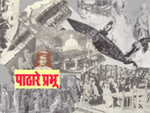The genesis of worship of mother-goddess can be traced to the remote past. The earliest extent depiction of a group of Matrkas (Divine mothers) in Indian sculpture may be pushed back safely to the Kusana period. This cult, however, became popular during the Gupta an subsequent periods. Likewise a number of records of the Calukyan kings, both eastern and western, clearly points out the fact that they were staunch adherents of the Matrka cult.
The discovery of a number of schist sculptures of fifth-sixth century A.D. from Samlaji has thrown a flood of light on the art and iconography. This group of stone sculptures includes several “Mother and child” specimens now preserved in the Baroda museum. Similar specimens of high iconographic interest were obtained from the neighbouring regions of Udaipur and Dungarpur in S.W. Rajasthan.
Recently a similar group of Matrkas sculptures of light green schist has been discovered lying in the open area of the newly constructed Vyasesvara Mahadeva Temple at Mataria. It is a small village situated at a distance of twelve km. to the east of Shahera in the Panchamahals district of the Gujarat state.
This group of seven Matrkas and an image of Bhairava as the guardian deity, are carved of green schist. One of them is the idol of Goddess Maheshwari.
This beautiful sculpture of Maheshwaridevi is depicted seated on the back of her vehicle the bull in the Ardhaparyankasana posture with the right leg folded. She carries a mirror in the left hand and mango twigs in the right hand. Her playful child is trying to jump upward behind her folded right leg. The coiffure is arranged elaborately with curls in front and a bun-like top from which issue ringlets, the bun being tied by a wreath of flowers with a central crest ornament of chakra motif. The Ratna-Kundalas of the earlobe and simple Prabhavali at the back of the face add a charm to the entire figure. She is also decked with ornaments like a simple Ekavali, armlets, bracelets, anklets, jewelled kathimetahla etc. The Uttariya put on by the Goddess is clearly visible near the elbow on either side. The lower garment (saree) is of a very transparent texture. The amra-lumbi (mango twigs) in the right hand is an interesting and uncommon depiction.
Reference: Matrka sculptures from Mataria and Ardhanariswara
From Tarsang (Panchamahals)
By : V. H. Sonawane
Courtesy: Mrs. Sheetal S. Mankar


